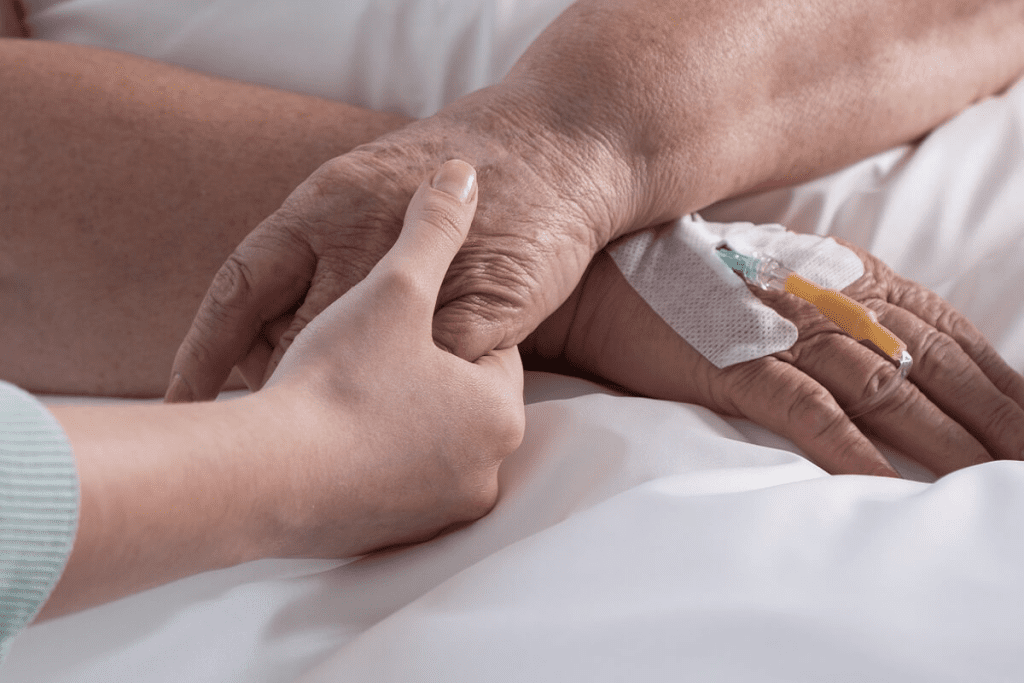Last Updated on October 21, 2025 by mcelik

Palliative chemotherapy represents a significant shift in treatment for many cancer patients.
Palliative chemotherapy represents a significant shift in treatment for many cancer patients.owth, not cure cancer. It’s not a cure, but it can greatly affect a patient’s life span and well-being. Knowing about palliative chemotherapy’s role in cancer care is key for making good choices.
Chemotherapy is a key part of cancer treatment. It uses strong drugs to kill cancer cells. Knowing its role is important for those facing cancer and their loved ones.
Chemotherapy uses chemicals to fight cancer. These chemicals stop cancer cells from growing and dividing, leading to their death. The drugs can be taken by mouth or given through an IV, based on the cancer type and treatment plan.
The main goals of chemotherapy differ for each patient. Some aim to cure the cancer. Others focus on easing symptoms and improving life quality.
It’s important to know the difference between curative and palliative care when dealing with cancer. Cancer treatment varies a lot. It depends on the cancer type, its stage, and the patient’s health.
When cancer is advanced or has spread, treatment goals may change. The focus shifts from curing the cancer to managing symptoms and improving life quality. This approach acknowledges that a cure might not be possible but aims to extend life.

Curative and palliative care have different approaches to treating cancer. Curative treatment uses aggressive methods like surgery, chemotherapy, and radiation. Palliative care, on the other hand, focuses on symptom relief and improving life quality.
Palliative chemotherapy is used to manage symptoms and improve life quality, not to cure cancer. The choice between these approaches depends on many factors, including cancer type, stage, and patient health.
The American Cancer Society notes, “Palliative care is specialized medical care for people with serious illnesses, like cancer. It aims to relieve symptoms and stress of serious illnesses.”
Palliative chemotherapy represents a significant shift in treatment for many cancer patients. It focuses on making them comfortable and controlling symptoms, not curing the cancer. This is for people with advanced cancer that can’t be cured anymore.
The main goals of palliative chemotherapy are:
Palliative chemotherapy is suggested when cancer is too advanced for curative treatments. Doctors and healthcare teams make this decision based on the patient’s health, cancer type and stage, and past treatments.
Reasons for recommending palliative chemotherapy include:
It’s important for patients and families to understand what palliative chemotherapy can do. It can improve life quality and possibly extend life, but it won’t cure cancer.
Knowing the benefits and limits of palliative chemotherapy helps patients make better care choices. They can discuss possible side effects, treatment length, and how it fits their personal goals and values.
Several key factors affect life expectancy in cancer treatment, including the type and stage of cancer.
The type and stage of cancer are very important. Different cancers grow at different rates and respond differently to treatment.
Early-stage cancers are usually easier to treat and have better survival rates. This is compared to late-stage cancers.
A patient’s overall health is a big factor in life expectancy during cancer treatment.
Things like age, other health conditions, and physical ability can affect how well a patient does. They can influence how well a patient can handle treatment and live longer.
Knowing how well a patient will respond to treatment is key to estimating life expectancy.
Biomarkers, genetic mutations, and how well a patient responds to treatment at first can give clues. These clues help predict if treatment will be successful.
| Factor | Influence on Life Expectancy | Considerations |
| Cancer Type | Varies by cancer type | Some cancers are more aggressive or harder to treat |
| Cancer Stage | Early stages have better prognosis | Stage at diagnosis is a key prognostic factor |
| Patient Health Status | Overall health affects treatment tolerance | Age, comorbidities, and physical function are important |
| Treatment Response | Predictors include biomarkers and initial response | Genetic mutations and treatment response are critical |
Palliative chemotherapy represents a significant shift in treatment for many cancer patients. longer and feel better. It’s used when the cancer can’t be cured. The goal is to make life longer and ease symptoms.
How long palliative chemotherapy extends life varies. It depends on the cancer type, stage, the patient’s health, and how well the treatment works.
Research shows that palliative chemotherapy can add months to years of life. The exact time varies a lot. It can be from 3 to 12 months.
Palliative chemotherapy represents a significant shift in treatment for many cancer patients.
The time life is extended by palliative chemotherapy varies by cancer type. For example:
Survival statistics are often given as median survival times. This means half of the patients live this long after starting treatment. It’s important to remember these numbers are averages. They don’t always predict what will happen to an individual.
| Cancer Type | Median Survival with Palliative Chemotherapy |
| NSCLC | 8-12 months |
| Colorectal Cancer | 6-12 months |
| Breast Cancer (Metastatic) | 2-3 years |
Knowing these statistics and how they relate to life extension can help patients and their families make better choices about their care.
Chemotherapy agents in palliative care vary widely. They range from traditional drugs to newer targeted therapies. The choice depends on the cancer type, the patient’s health, and past treatments.
Cytotoxic drugs are the traditional mainstay of cancer treatment. They kill fast-growing cells, like cancer cells. Examples include:
Though effective, these drugs can harm normal cells, leading to side effects.
Targeted therapies are a newer cancer treatment approach. They aim at specific molecules that help cancer grow. Examples are:
These therapies can be more effective and have fewer side effects than traditional drugs.
Chemotherapy often uses a mix of agents. This method can fight resistance, boost response rates, and possibly extend life.
| Therapy Type | Examples | Mechanism |
| Cytotoxic | Doxorubicin, Cyclophosphamide | Kill rapidly dividing cells |
| Targeted | Trastuzumab, Imatinib | Target specific cancer-related molecules |
| Combination | Various combinations (e.g., AC: doxorubicin + cyclophosphamide) | Multi-faceted attack on cancer cells |
Choosing chemotherapy agents in palliative care needs careful thought. It’s about weighing benefits against risks. Knowing the different agents helps patients and doctors make better treatment choices.
Palliative chemotherapy works differently for each cancer type. Knowing these differences helps make better treatment choices.
Palliative chemotherapy helps lung cancer patients live longer. Research shows it boosts their survival times.
Chemotherapy helps colorectal cancer patients live longer. Studies show it greatly improves their survival chances.
In breast cancer, chemotherapy controls symptoms and boosts quality of life. It also increases survival rates.
Chemotherapy is also used for cancers like pancreatic and ovarian. It improves survival rates and quality of life for these patients.
Finding the right balance between living longer and enjoying life is hard. Palliative chemotherapy tries to do this by managing symptoms and pain. It also helps patients stay functional. Managing treatment side effects well is key to keeping patients active.
Doctors and patients work together to set treatment goals. This team effort ensures the treatment fits the patient’s values and needs.
Managing symptoms is a big part of palliative care. It tackles issues like pain, nausea, and fatigue. Advanced symptom management techniques and medicines are vital for better quality of life.
A detailed symptom management plan is made with the patient and their caregivers. This plan is updated often to meet the patient’s changing needs.
Keeping patients functional is important during palliative chemotherapy. It lets them keep up with daily life, stay independent, and enjoy activities. Rehabilitation and supportive care services are part of the treatment to support physical and emotional health.
Regular checks are done to see how patients are doing. This helps make care plans better and address any issues quickly. It ensures patients get the support they need.

When patients get palliative chemotherapy, it’s key to know and deal with side effects. This treatment aims to better life quality and maybe extend life. But, it can cause side effects that affect how patients feel.
Palliative chemotherapy can lead to physical side effects like fatigue, nausea, vomiting, hair loss, and neuropathy. These can really change a patient’s life quality.
Common side effects include:
Long-term effects of palliative chemotherapy can include secondary cancers, organ damage, and lasting neuropathy. Knowing these risks is important for patients and doctors.
| Complication | Description |
| Secondary Cancers | Cancers that develop as a result of chemotherapy treatment |
| Organ Damage | Damage to organs such as the heart, kidneys, or liver due to chemotherapy |
| Persistent Neuropathy | Nerve damage that can cause pain, numbness, or tingling |
Managing side effects well is key to keeping quality of life during palliative chemotherapy. Ways to do this include using medicine, making lifestyle changes, and trying alternative therapies.
Key management strategies:
By knowing about side effects and using good management strategies, patients can have a better life quality during palliative chemotherapy.
Choosing Palliative chemotherapy represents a significant shift in treatment for many cancer patients.ht and talking among everyone involved. This includes the patient, their doctor, family, and support groups.
Physician-patient communication is key. It’s about talking about the patient’s health, treatment choices, and what might happen. Patients should ask about the good and bad of palliative chemotherapy.
Open dialogue helps set clear expectations. It also lets patients share their wishes and values. This talk keeps going as the patient’s health changes.
It’s important to balance the good and bad of palliative chemotherapy. The benefits include feeling better, living better, and maybe living longer. But, there are risks like feeling tired, sick to your stomach, and losing hair.
| Benefits | Risks/Side Effects |
| Symptom relief | Fatigue |
| Improved quality of life | Nausea and vomiting |
| Potentially extended survival | Hair loss |
Choosing Palliative chemotherapy represents a significant shift in treatment for many cancer patients. Their families must deal with the outlook and what treatment means. Support from doctors, family, and groups is very important.
The family and support system are very important. They offer emotional support, help understand treatment, and make decisions when needed. Their care and comfort are invaluable.
When thinking about palliative chemotherapy, weighing its benefits against risks is key. This treatment isn’t right for everyone, like those with very advanced cancer or poor health.
Palliative chemotherapy represents a significant shift in treatment for many cancer patients.
A study in the Journal of Clinical Oncology showed that those with poor performance status face more risks and hospital stays with chemotherapy. So, it’s vital to check a patient’s performance status before starting palliative chemotherapy.
| Performance Status | Description | Potential Outcome with Palliative Chemotherapy |
| ECOG 0-1 | Fully active or restricted in physically strenuous activity | May benefit from palliative chemotherapy |
| ECOG 2-3 | Restricted in activity, capable of self-care, or limited in self-care | May have limited benefit, careful assessment needed |
| ECOG 4-5 | Completely disabled, unable to perform self-care, or deceased | Generally not recommended |
In some cases, palliative chemotherapy might not offer much benefit. This is true for patients with advanced cancer that hasn’t responded to other treatments.
Factors that may limit the expected benefit include:
What patients want and value is very important when deciding on palliative chemotherapy. Some might choose quality of life over more time, while others might want to try treatment even if benefits are small.
It’s essential to have open and honest discussions between patients, their families, and healthcare providers to understand the patient’s goals and preferences.
By looking at these factors, patients and their healthcare providers can make informed choices about palliative chemotherapy.
Palliative chemotherapy represents a significant shift in treatment for many cancer patients.
Non-pharmacological interventions are key in palliative care. They include physical therapy, occupational therapy, and psychological support.
These interventions help patients stay functional and feel better overall.
Supportive care helps manage symptoms and pain. It also improves life quality. Services include nutritional support, pain management, and emotional counseling.
Integrative approaches mix traditional treatments with complementary therapies. Examples are acupuncture and massage therapy.
Doctors check how well palliative chemotherapy works by doing clinical checks and tests. This way, they can see if the treatment is helping and make changes if needed.
Tests like CT scans or MRI help see how tumors are doing. Blood tests check the patient’s health and look for side effects.
Key Imaging and Laboratory Tests:
| Test Type | Purpose | Frequency |
| CT Scan | Assess tumor size and spread | Every 2-3 months |
| Blood Tests | Monitor blood cell counts and organ function | Regularly, as advised by the doctor |
| MRI | Detailed imaging of tumors and surrounding tissues | As needed, based on clinical judgment |
Checking symptoms is key to seeing if treatment is working. Doctors look at pain, nausea, or fatigue to see if the treatment is helping.
Effective symptom management means more than just medicine. It also includes lifestyle changes and support. This way, doctors can adjust the treatment plan as needed.
Doctors think about changing treatment based on what they find. If the tumor isn’t getting smaller or symptoms get worse, they might change the plan.
Factors Influencing Treatment Changes:
By always checking how well treatment is working and making changes, doctors can make palliative chemotherapy better for patients.
Palliative chemotherapy represents a significant shift in treatment for many cancer patients.tend life and improve quality of life for patients. We’ve looked at its definition, goals, and benefits in this article.
Knowing about palliative chemotherapy is important for patients and their families. We’ve talked about how cancer type and stage, patient health, and treatment response affect life expectancy. This helps people make better care choices.
The success of palliative chemotherapy varies by cancer type. Different cancers have different survival rates and life extension outcomes. It’s important to balance survival with quality of life. Managing symptoms, keeping function during treatment, and supportive care are all vital.
Palliative chemotherapy represents a significant shift in treatment for many cancer patients.
Palliative chemotherapy aims to make life better for patients with advanced cancer. It helps manage symptoms, slow disease growth, and control pain.
Side effects include fatigue, nausea, hair loss, and low blood cell counts. The exact side effects depend on the chemotherapy type.
Effectiveness is checked by managing symptoms, improving quality of life, and tumor response. This involves tests, lab work, and patient feedback.
No, it’s not meant to cure cancer. Its main goal is to enhance life quality for those with advanced cancer.
Life extension varies by cancer type, stage, and overall health. On average, it can add several months to life.
Palliative care boosts life quality for those with serious illnesses, like cancer. It manages symptoms, reduces pain, and improves well-being.
Deciding on palliative chemotherapy depends on personal circumstances. It may not cure cancer but can improve life quality and survival.
Alternatives include supportive care, pain management, and symptom control. These can be used alone or with chemotherapy.
Stopping chemotherapy is a team decision. It considers the patient’s health, treatment success, and personal wishes.
Neugut, A. I., et al. (2017). Curative, lifeextending, and palliative chemotherapy. The Oncologist, 22(3), 312-317. https://www.ncbi.nlm.nih.gov/pmc/articles/PMC5553954/
Subscribe to our e-newsletter to stay informed about the latest innovations in the world of health and exclusive offers!